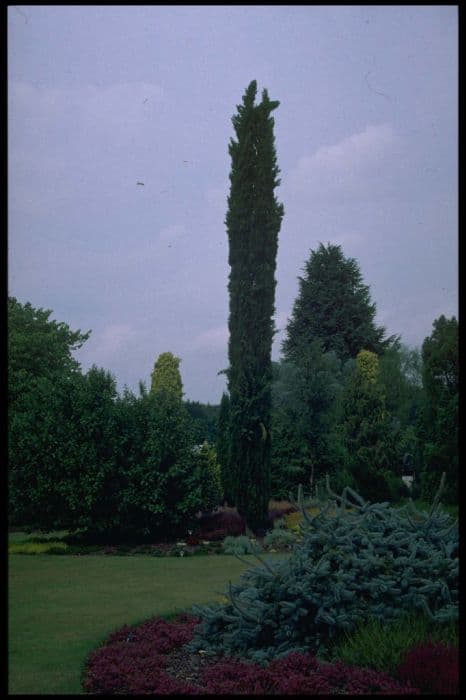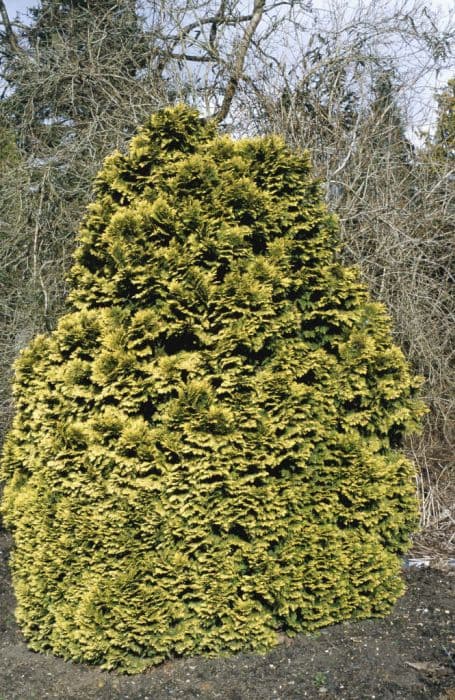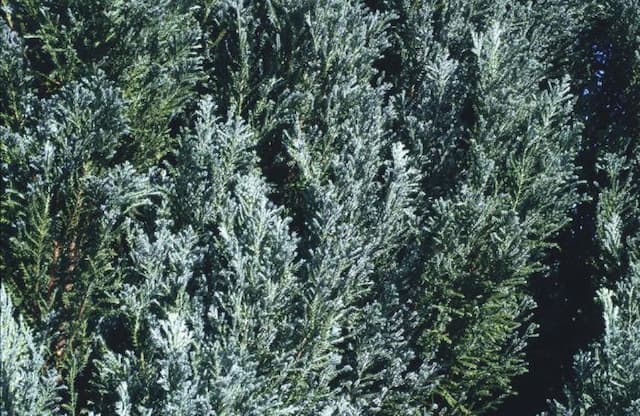Italian Cypress Cupressus sempervirens 'Green Pencil'

ABOUT
The 'Green Pencil' is a cultivar of the Italian cypress, characterized by its particularly narrow and columnar growth habit, giving it a pencil-like appearance. It has dense, evergreen foliage that presents in a dark green hue. The leaves of this plant are tiny and scale-like, clinging closely to the erect branches. Revealing very little of the reddish-brown branches, the leaves create a smooth texture from afar but feel rather rough when touched. The growth pattern of 'Green Pencil' displays a formal and upright habit with very little spreading, which makes it ideal for use in creating vertical accents in landscape designs. The tree has an overall dense and compact form, looking like a tall, slender column of greenery. It is often planted in rows to create a privacy screen or windbreak due to its tightly packed leaves and narrow shape. This elegant cultivar is also appreciated for its ability to retain a consistent color and form throughout the year, with very little variation across seasons.
About this plant
 Names
NamesFamily
Cupressaceae
Synonyms
Italian Cypress, Mediterranean Cypress, Tuscan Cypress, Graveyard Cypress
Common names
Cupressus sempervirens 'Green Pencil'.
 Toxicity
ToxicityTo humans
The Italian Cypress (Cupressus sempervirens 'Green Pencil') is not commonly known to be toxic to humans. Generally, the plant does not pose a risk if touched or handled; however, like many plants, ingesting parts of the Italian Cypress may cause gastrointestinal discomfort, such as nausea, vomiting, or diarrhea. These symptoms could occur if large amounts of plant material are consumed, which is uncommon as the plant is not considered edible.
To pets
The Italian Cypress (Cupressus sempervirens 'Green Pencil') is not listed as a commonly toxic plant to pets such as dogs and cats. However, ingestion of plant parts might still lead to mild gastrointestinal upset, resulting in symptoms like vomiting or diarrhea, especially if consumed in large amounts. It is not typically considered to have severe toxic effects on pets. Owners should still prevent their pets from eating ornamental plants, as individual animals might have different sensitivities or allergic reactions.
 Characteristics
CharacteristicsLife cycle
Perennials
Foliage type
Evergreen
Color of leaves
Green
Height
20 feet (6 meters)
Spread
2 feet (0.6 meters)
Plant type
Tree
Hardiness zones
7
Native area
Mediterranean
Benefits
 General Benefits
General Benefits- Ornamental Appeal: The Italian Cypress, as it is commonly known, adds a touch of Mediterranean elegance to landscapes, with its tall, narrow, columnar shape and lush green foliage.
- Space Efficient: Due to its slender growth habit, it is ideal for tight spaces and can be used to create vertical design elements in small gardens or urban settings.
- Privacy Screen: Its dense growth makes it an excellent choice for creating privacy screens or hedges without taking up too much horizontal space.
- Low Maintenance: Once established, the Italian Cypress requires minimal care and is drought-tolerant, making it suitable for xeriscaping and reducing the need for frequent watering.
- Windbreak: The thick foliage and tall stature of the tree can act as a windbreak, providing shelter from strong winds for other plants or outdoor living areas.
- Soil Adaptability: It can adapt to a wide range of soil conditions as long as they are well-drained, making it a versatile choice for different garden types.
- Disease Resistance: This cultivar is generally resistant to many common diseases that affect other garden plants, reducing the need for chemical treatments.
 Medical Properties
Medical Properties- Antiseptic: The essential oil of the Cypress tree includes components with antiseptic qualities, which may help kill bacteria and prevent wound infections.
- Antispasmodic: Cypress oil has been traditionally used to relieve spasms and associated conditions such as muscle cramps.
- Astringent: Cypress can act as an astringent, causing tissues to contract, which may aid in reducing excessive bleeding or fluid discharge in minor wounds.
- Diuretic: The plant has been historically used to increase urination, thereby potentially helping to remove toxins from the body.
- Vasoconstrictor: The essential oil of Cypress is said to have vasoconstricting effects, which might be useful in reducing bleeding from varicose veins.
- Hemostatic and Styptic: The essential oil can act as a hemostatic or styptic agent, helping to stop the flow of blood in case of minor cuts or bleeding.
- Sedative: Cypress essential oil might have a sedative effect, helping to calm the nerves and soothe the mind.
 Air-purifying Qualities
Air-purifying QualitiesThis plant is not specifically known for air purifying qualities.
 Other Uses
Other Uses- Cypress woodchips from Cupressus sempervirens can be used as mulch in gardens to suppress weeds and retain soil moisture.
- Cypress branches can be utilized for rustic fencing or garden trellises to support climbing plants due to their durability and natural appearance.
- The dense, columnar growth of the cypress can serve as a visual barrier for privacy screens or windbreaks in landscaping.
- Wood from the cypress can be crafted into small decorative items or furniture, taking advantage of its fine grain and workability.
- The tree's aromatic foliage can be used in potpourris or as natural insect repellents when placed in wardrobes or drawers.
- Dried cypress branches can offer a sustainable alternative for fireplace kindling or for use in outdoor fire pits.
- The cypress's cone seeds can be collected and used in craft projects or as part of homemade jewelry, e.g., necklaces or earrings.
- Cypress sap resin has been traditionally used for making varnishes or as a component in perfumery.
- Its narrow and upright form makes the cypress a popular subject in bonsai, where it can be trained into miniature versions of its natural shape.
- The fibrous bark of the cypress can be used in small-scale crafting projects, like creating natural textures in modeling or artwork.
Interesting Facts
 Feng Shui
Feng ShuiThe Italian Cypress is not used in Feng Shui practice.
 Zodiac Sign Compitability
Zodiac Sign CompitabilityThe Italian Cypress is not used in astrology practice.
 Plant Symbolism
Plant Symbolism- Immortality: Cypress trees are often associated with immortality due to their long lifespan and evergreen foliage.
- Mourning: The cypress is commonly found in cemeteries and is a symbol of mourning and sorrow in various cultures.
- Eternity: The tree's durability and the fact that it remains green all year round symbolizes eternal life.
- Resilience: Cypress trees can withstand harsh conditions, symbolizing strength and the ability to endure difficulties.
- Hope: In some cultures, the cypress represents hope, as it points towards the heavens and inspires people to look upward during tough times.
- Protection: Historically, cypresses were planted around homes and sanctuaries to ward off evil spirits, thus they symbolize a protective force.
- Transition: The tree's association with cemeteries also makes it a symbol of the transition between life and death.
 Water
WaterThe Italian Cypress should be watered deeply and slowly to ensure the soil is moistened to a depth of a few inches. Newly planted trees require more frequent watering—about once a week—especially during hot and dry periods. For established trees, reduce watering to once every two to three weeks, applying approximately 1 to 1.5 gallons per watering session. Adjustments may be needed based on weather conditions, with less water required during rainy seasons and more during droughts. Ensure that the soil allows for suitable drainage to prevent root rot.
 Light
LightItalian Cypresses thrive best in full sun conditions, receiving at least six hours of direct sunlight daily. They should be placed in a spot that is well-exposed to sunlight throughout the day. They are tolerant of different light exposures but will achieve their best growth and form in sunny locations.
 Temperature
TemperatureItalian Cypresses prefer a temperate climate with temperatures ranging from 20°F to 100°F, while they can withstand slightly colder temperatures, they perform best when not subjected to prolonged periods of freezing conditions. The ideal temperature for this conifer is between 60°F and 80°F, where they experience robust growth.
 Pruning
PruningPruning Italian Cypresses is primarily for shaping or removing damaged branches, done in the late winter or early spring before new growth starts. This conifer has a natural columnar shape, so little pruning is typically required. Any shaping should maintain that natural form. If necessary, trim to control their height or width only once a year.
 Cleaning
CleaningAs needed
 Soil
SoilItalian Cypress or Mediterranean Cypress ('Green Pencil') prefers a well-draining soil mix with sand, clay, and organic matter. The best soil pH for this plant is slightly acidic to neutral, ranging from 6.0 to 7.5.
 Repotting
RepottingItalian Cypress typically does not require frequent repotting. This plant can be repotted every 3 to 5 years, as it is slow-growing and has a relatively small root system.
 Humidity & Misting
Humidity & MistingItalian Cypress tolerates a wide range of humidity levels but thrives best in moderate to low humidity conditions. It's well-suited to the average outdoor humidity in its growing zones.
 Suitable locations
Suitable locationsIndoor
Provide direct sunlight, good airflow, minimal water.
Outdoor
Plant in full sun, well-draining soil, shelter from wind.
Hardiness zone
7-11 USDA
 Life cycle
Life cycleCupressus sempervirens 'Green Pencil', commonly known as the Italian Cypress or Mediterranean Cypress, begins its life cycle with seed germination, which occurs in a moist environment after stratification, a process that breaks seed dormancy. After germination, the seedling grows gradually, developing a strong taproot and foliage characteristic of cypresses. As it matures into a young tree, the Italian Cypress exhibits rapid vertical growth with a columnar habit, requiring minimal lateral space. It reaches its reproductive maturity after several years, producing cones that are wind-pollinated, with male and female cones typically found on the same tree. The mature cones release seeds that can perpetuate the cycle, while the trees themselves can live for several centuries under ideal conditions. Throughout its life, the Italian Cypress remains evergreen, with minimal leaf drop and consistent year-round foliage.
 Propogation
PropogationPropogation time
Spring-Early Summer
The most popular method of propagating the Italian Cypress 'Green Pencil' is through semi-hardwood cuttings. This process generally takes place in late summer to early fall when the new growth has begun to mature and harden slightly. To propagate, one would cut a 6 to 8-inch (15 to 20 cm) length of semi-hardwood stem from the current year's growth, ensuring that several leaf nodes are included. The lower end of the cutting should be dipped into a rooting hormone to encourage root development and then planted into a well-draining potting mix. The cutting should be kept in a warm, humid environment, avoiding direct sunlight to prevent drying out, until the roots have established, which commonly takes several weeks to a few months.









